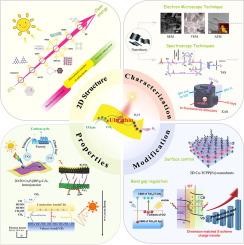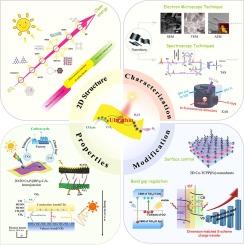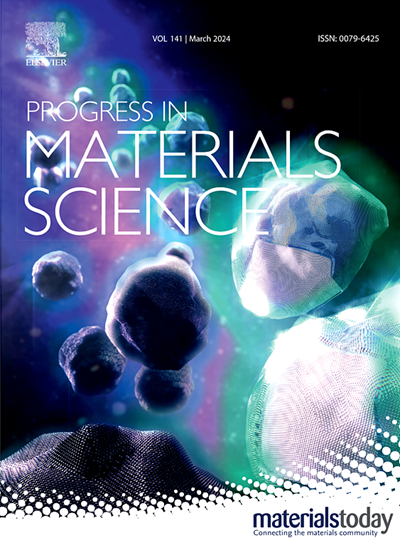用于光催化还原二氧化碳的二维材料的多尺度结构调控
IF 33.6
1区 材料科学
Q1 MATERIALS SCIENCE, MULTIDISCIPLINARY
引用次数: 0
摘要
通过光催化将二氧化碳(CO2)转化为可持续燃料和化学品,是加强自然碳循环和应对全球变暖的一种前景广阔的方法。这种方法涉及开发高效、稳定和具有成本效益的光催化剂,而石墨氮化碳(g-C3N4)和氢铝酸盐等二维(2D)材料因其广泛的表面积和卓越的电荷分离和转移能力而脱颖而出。这些材料的薄度缩短了载流子传输路径,改善了二氧化碳和水的吸附和活化,降低了能量障碍,并选择性地增强了特定反应。然而,仅仅关注厚度可能会使问题过于简单化,因为形态、边缘结构、活性位点暴露和界面效应也对光催化性能起着至关重要的作用。通过厚度等纳米参数调整电子结构固然重要,但全面考虑这些复杂的相互作用也至关重要。虽然以往的研究已经考察了二维材料的性能和优化,但缺乏对厚度和结构-活性关系的深入分析,这阻碍了催化剂的先进设计。本综述讨论了各种二维纳米材料的结构特征、它们在促进电子-空穴对分离、快速电子迁移和有效吸附二氧化碳方面的作用,还评估了这些材料在燃料利用方面的未来前景和挑战。本文章由计算机程序翻译,如有差异,请以英文原文为准。


Multiscale structural regulation of Two-Dimensional materials for photocatalytic reduction of CO2
The photocatalytic conversion of carbon dioxide (CO2) into sustainable fuels and chemicals is a promising method to enhance the natural carbon cycle and combat global warming. This approach involves developing efficient, stable, and cost-effective photocatalysts, with two-dimensional (2D) materials like graphitic carbon nitride (g-C3N4) and hydrotalcite standing out owing to their extensive surface areas and superior charge separation and transfer capabilities. The thinness of these materials shortens carrier transport paths, improves CO2 and water adsorption and activation, lowers energy barriers, and selectively enhances specific reactions. However, focusing solely on thickness might oversimplify the issue, as morphology, edge structures, active site exposure, and interfacial effects also play crucial roles in photocatalytic performance. Adjusting electronic structures through nanoscale parameters like thickness is vital, but a comprehensive consideration of these complex interactions is essential. While previous studies have examined the performance and optimization of 2D materials, in-depth analyses of thickness and structure–activity relationships are lacking, which hinders advanced catalyst design. This review discusses the structural characteristics of various 2D nanomaterials, their role in promoting electron-hole pair separation, rapid electron migration, and effective CO2 adsorption, and also evaluates future prospects of these materials in fuel utilizations and the challenges.
求助全文
通过发布文献求助,成功后即可免费获取论文全文。
去求助
来源期刊

Progress in Materials Science
工程技术-材料科学:综合
CiteScore
59.60
自引率
0.80%
发文量
101
审稿时长
11.4 months
期刊介绍:
Progress in Materials Science is a journal that publishes authoritative and critical reviews of recent advances in the science of materials. The focus of the journal is on the fundamental aspects of materials science, particularly those concerning microstructure and nanostructure and their relationship to properties. Emphasis is also placed on the thermodynamics, kinetics, mechanisms, and modeling of processes within materials, as well as the understanding of material properties in engineering and other applications.
The journal welcomes reviews from authors who are active leaders in the field of materials science and have a strong scientific track record. Materials of interest include metallic, ceramic, polymeric, biological, medical, and composite materials in all forms.
Manuscripts submitted to Progress in Materials Science are generally longer than those found in other research journals. While the focus is on invited reviews, interested authors may submit a proposal for consideration. Non-invited manuscripts are required to be preceded by the submission of a proposal. Authors publishing in Progress in Materials Science have the option to publish their research via subscription or open access. Open access publication requires the author or research funder to meet a publication fee (APC).
Abstracting and indexing services for Progress in Materials Science include Current Contents, Science Citation Index Expanded, Materials Science Citation Index, Chemical Abstracts, Engineering Index, INSPEC, and Scopus.
 求助内容:
求助内容: 应助结果提醒方式:
应助结果提醒方式:


